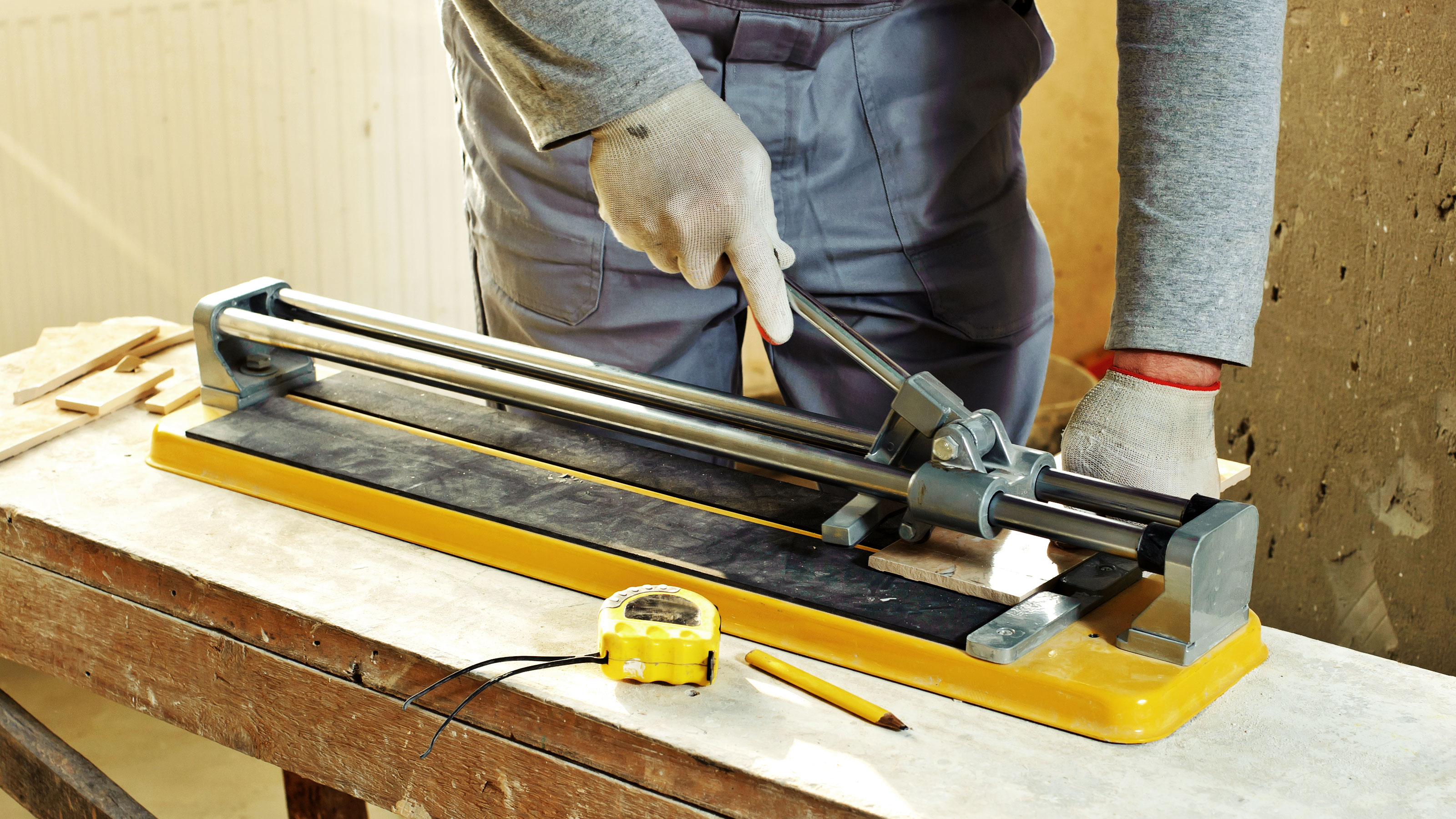How to use a tile cutter — plus when to use a wet saw instead
Knowing how to use a tile cutter is a key skill for any DIY tiler. Here we tell you how to cut different types of tiles and what type of tile cutter you'll need

If you want to cut tiles you need to know how to use a tile cutter. But it's not quite as straightforward as you might think. There are different types of tile cutters, different sizes, and different price points. So you will need to choose a tile cutter that is going to work for your tiling project.
If you’re tiling a kitchen wall with metro tiles you will typically only need simple straight cuts, so a manual tile cutter is more than up to the job. But if you are using larger, thicker tiles for a wall or floor, or cuts that are less than straightforward then you will need to consider an electric tile cutter.
Here we run through the key techniques for cutting tiles, what type of cutter you might need and answer a few common questions to help you get a pro looking finish.
How to use a tile cutter: A quick guide to using a manual cutter
Here we look at how you use a manual tile cutter to cut get straight cuts on tiles.
1. Mark and score tile
Measure up and mark where you want your tile with a felt tip pen. This should wipe off easily after you have cut the tile, but obviously do a test line first to double check. Some manual tile cutters allow you to adjust the height of the scoring wheel by unscrewing the handle. If this is the case move it into position and tighten the handle to hold it in place.
Now place the tile on the cutter, push up against the ruler and line up your felt tip mark with the scoring wheel. The base has a small ridge that lines up with the scoring wheel; you can use this as a guide as well.
Pull back the handle so it's at the furthest edge on the tile from the ruler, quickly check that the scoring wheel is lined up with your mark, securely hold the tile and push the scoring wheel down and forward to score the tile. If new to tiling practice this a few times on spare tiles.
2. Break tile
With the score line in place and handle pushed forward the breaker – aka snapper – will now come into use. Make sure the snapper is in place – it should be automatically – gently push down on the handle until the tile snaps.
Now lift the handle and remove the two parts of the tile. Note that if you have a small slither that needs cutting – around 10mm – you will need to use a pair of tile nippers like the Amtech Tile Nipper from Amazon, or a wet saw (electric tile cutter). If you get a rough edge, use a fine grade sandpaper and sanding block to smooth out the edge.
Is it better to use a tile cutter or wet saw?
This will depend on what type of tiling job you are tackling. If you are tiling a corner or a wall and you only need straight cuts then a manual tile cutter is typically the best choice. You will just need to consider what size you need.
If you are going to be taking on everyday DIY tiling tasks like tiling a kitchen splashback, or tiling a bathroom wall and you are only using standard sized tiles like 150mm x150mm or 100m x 200mm, then you don’t necessarily need a big tiler cutter. However, it’s worth checking the manufacturer specs to see what tile thickness the tile cutter can cut.
However, a larger tile cutter like the TOPWAY Manual Tile Cutter from Amazon will give you more options. And it helps negate the need to buy a new tile cutter in the future when you decide on large 600mm tiles to spruce up your kitchen or bathroom. Larger tiles cutters also typically cut thicker tiles.
A wet saw is a good choice if you need small straight cuts, double cuts on a single tile or you are working with delicate tiles. You typically get a smoother finish as you are cutting rather than snapping the tile.
You can use a compact wet saw like the VITREX Diamond Blade Tile Cutting Saw from Amazon if using smaller tiles. However, a larger wet saw with a more powerful motor is ideal if cutting larger tiles.
Wet saws/ electric tile cutters make more mess as they create more dust, which mixes with the water that keeps the tile cool. And you will need a power outlet if you don’t have a cordless model.
Which tiles are the hardest to cut?
Of the tiles typically used in the home it's very much a toss up between porcelain and ceramic tiles, with porcelain tiles being the harder tile to cut. But, they are more durable and ideally you will need a wet saw to cut them. Check out our Porcelain vs Ceramic Tiles guide to find out the differences.
How thick a tile can a tile cutter cut?
This depends on what type of tile cutter you are using. But as a general rule a manual tile cutter that uses a score and snap action, typically cuts tiles up to 15mm in thickness. But again it will depend on the size of the cutter. Check the specs of a tile cutter to get the manufacturer's recommendation.
A wet saw/electric tile cutter with the right blade will typically cut thicker tiles, up to around 30mm. Alternatively, you can use the best angle grinders with a diamond blade cutting disc to cut through thick tiles.
Get the Homebuilding & Renovating Newsletter
Bring your dream home to life with expert advice, how to guides and design inspiration. Sign up for our newsletter and get two free tickets to a Homebuilding & Renovating Show near you.
Steve Jenkins is a freelance content creator with over two decades of experience working in digital and print and was previously the DIY content editor for Homebuilding & Renovating.
He is a keen DIYer with over 20 years of experience in transforming and renovating the many homes he has lived in. He specialises in painting and decorating, but has a wide range of skills gleaned from working in the building trade for around 10 years and spending time at night school learning how to plaster and plumb.
He has fitted kitchens, tiled bathrooms and kitchens, laid many floors, built partition walls, plastered walls, plumbed in bathrooms, worked on loft conversions and much more. And when he's not sure how to tackle a DIY project he has a wide network of friends – including plumbers, gas engineers, tilers, carpenters, painters and decorators, electricians and builders – in the trade to call upon.

